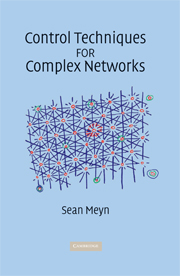Book contents
6 - Routing and Resource Pooling
from Part II - Workload
Published online by Cambridge University Press: 17 March 2011
Summary
In the preceding chapters we learned that resources in a network must be shared among different classes of customers. This sharing is performed through scheduling at each station in the network.
Scheduling is just one of many decision processes encountered in typical applications. In the Internet there are many paths between nodes, and hence protocols must be constructed to determine appropriate routes. In a power distribution system there may be many generators that can meet current demands distributed across the power grid. A manufacturing system may have redundant processing equipment, or multiple vendors, and this then leads to a network somewhat more complex than those considered in the previous two chapters.
Figure 6.1 shows a network with eight nodes, four arrival streams, and ten links. The high congestion between nodes 1 and 3 can be modeled through an additional linear constraint on the rate vector ζ in a fluid model. There are many routes from node 1 to node 8, even though node 4 is temporarily unavailable. This example demonstrates that there may be many equilibria in a routing model; the best route for a given user will depend upon the current environment.
Most of the concepts introduced in previous chapters, such as stabilizability and workload relaxations, will be extended to this more general setting. Consideration is largely restricted to a fluid model since the definitions are most transparent in this setting.
- Type
- Chapter
- Information
- Control Techniques for Complex Networks , pp. 195 - 245Publisher: Cambridge University PressPrint publication year: 2007

